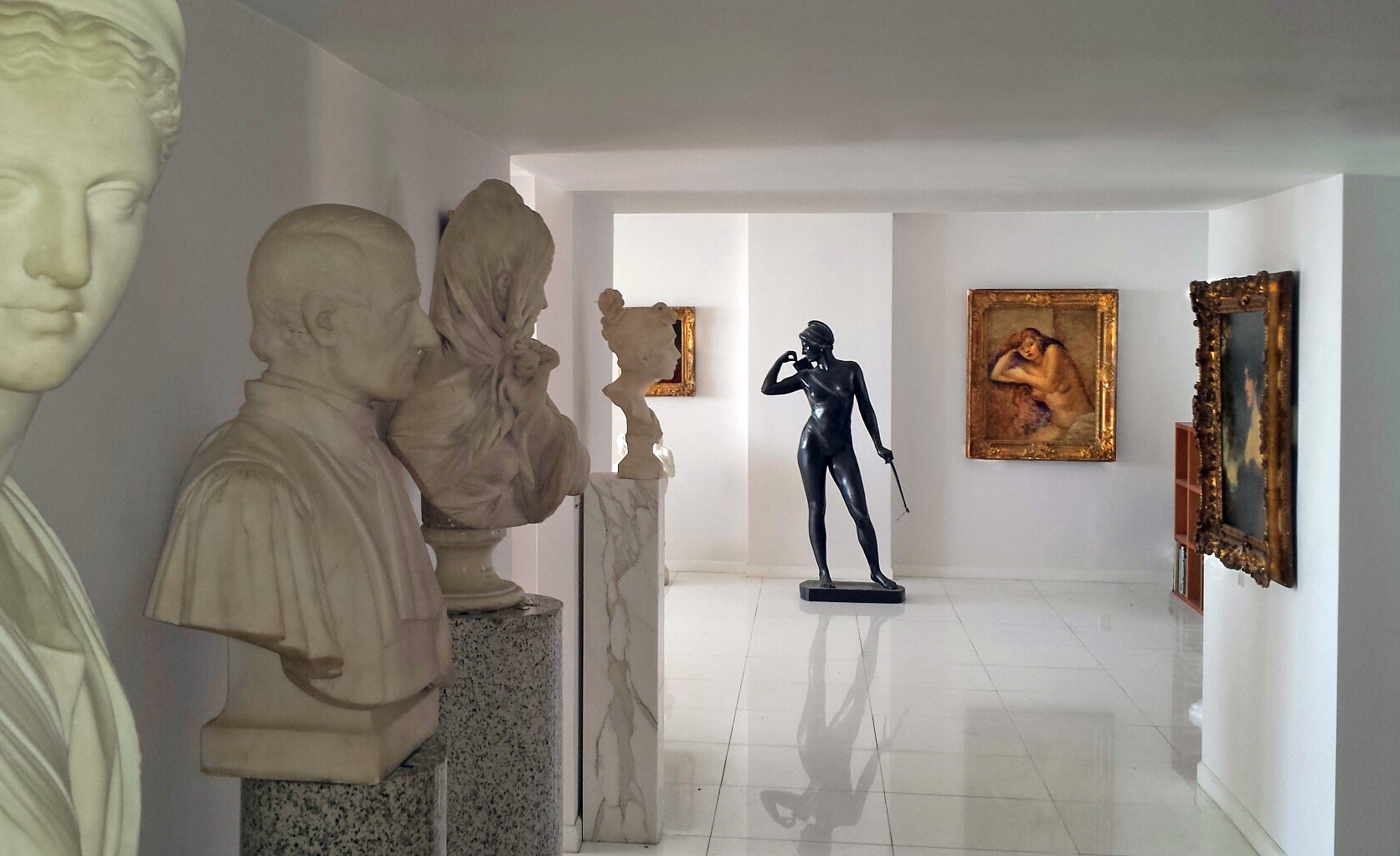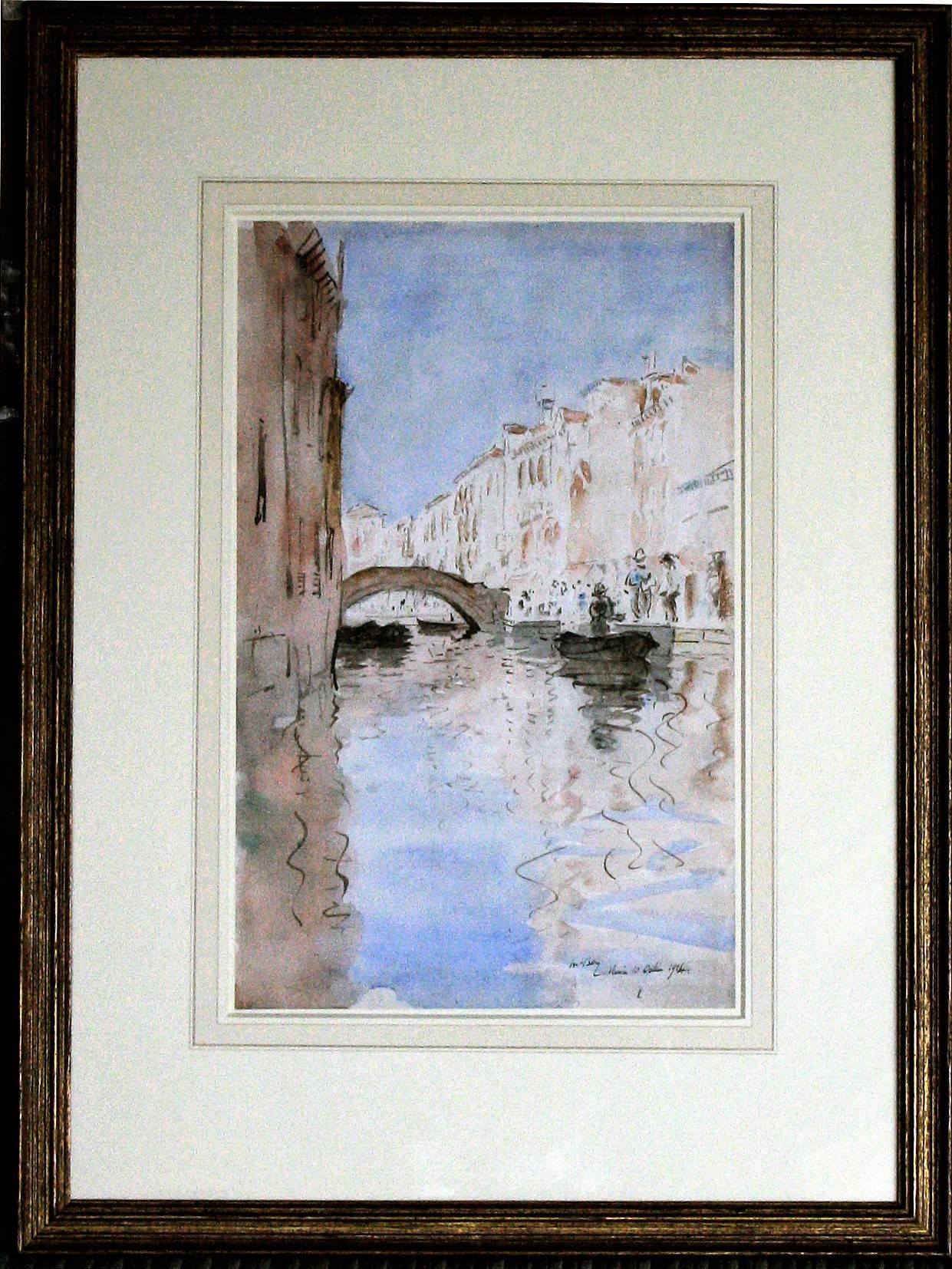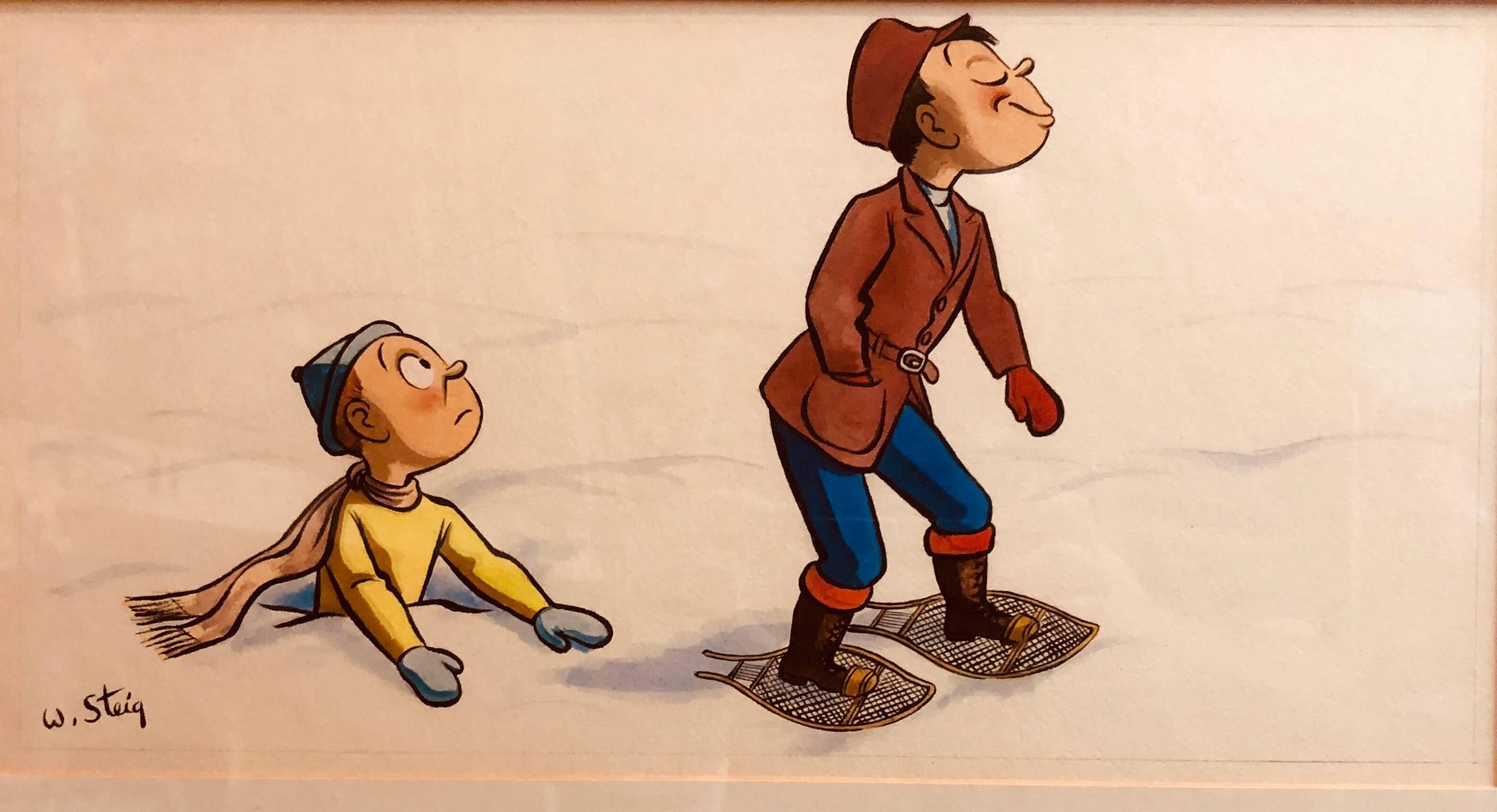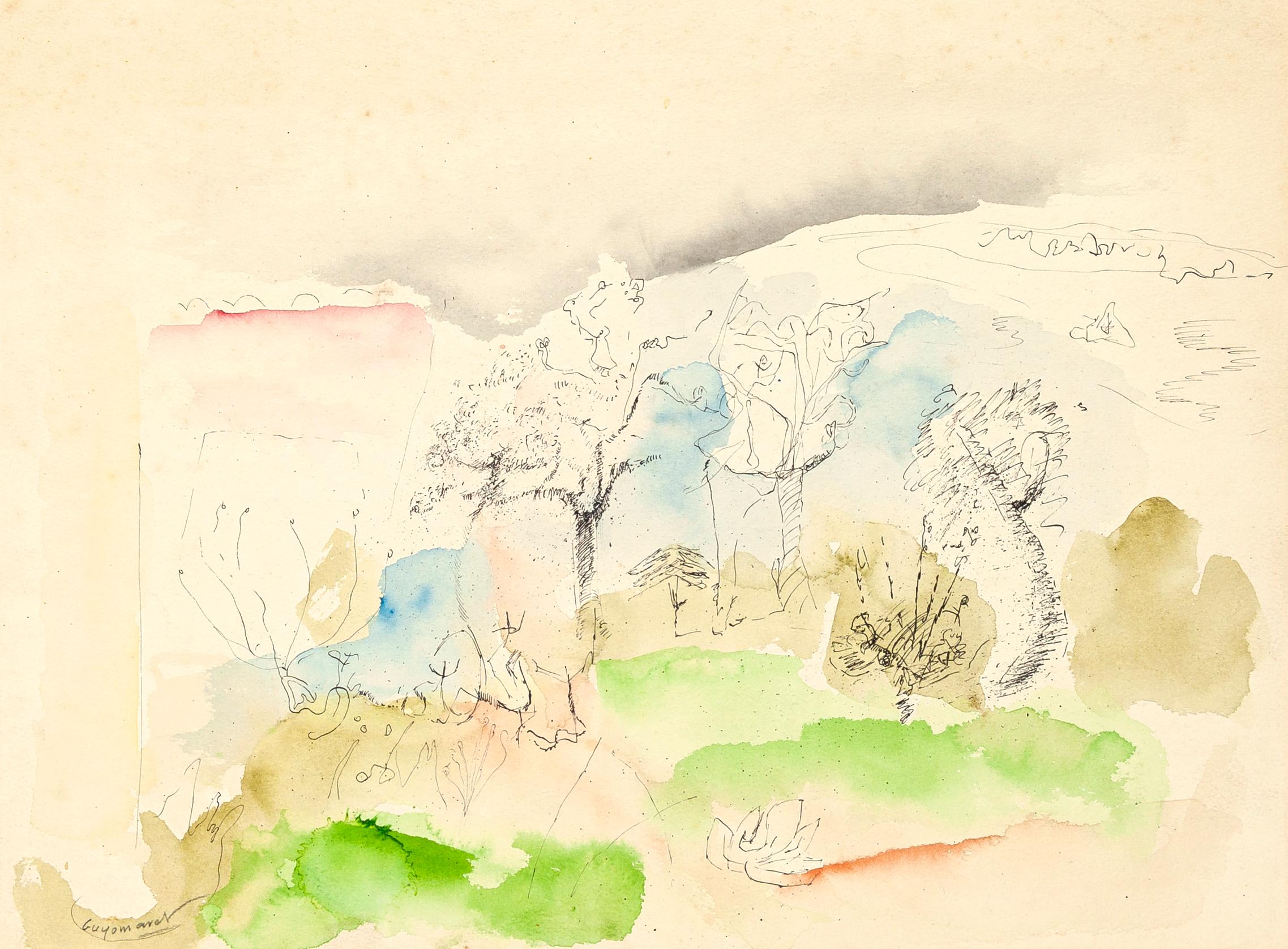Items Similar to Shine On, Virginia Woolf
Want more images or videos?
Request additional images or videos from the seller
R.O. BLECHMANShine On, Virginia Woolf1997
1997
About the Item
"Shine On, Virginia Woolf!" Cover illustration for The New York Times Book Review, published June 8, 1997. Airbrush on paper with mylar overlay with marker. 273x248 mm; 10 3/4x9 3/4 inches, on 17x14-inch sheet. Signed "Blechman" on overlay. Archivally hinged to matte.
- Creator:R.O. BLECHMAN (1930)
- Creation Year:1997
- Dimensions:Height: 10.75 in (27.31 cm)Width: 9.75 in (24.77 cm)
- Medium:
- Movement & Style:
- Period:
- Condition:
- Gallery Location:Miami, FL
- Reference Number:1stDibs: LU38534775212

About the Seller
4.9
Gold Seller
These expertly vetted sellers are highly rated and consistently exceed customer expectations.
Established in 2005
1stDibs seller since 2016
102 sales on 1stDibs
Typical response time: 1 hour
- ShippingRetrieving quote...Ships From: Miami, FL
- Return PolicyA return for this item may be initiated within 3 days of delivery.
More From This SellerView All
- Environmental Prognostication Coil Narrative "Homo Sapiens R.I.P."Located in Miami, FL"They paved paradise and put up a parking lot," Joni Mitchell said. - - Created in 1969, at the dawn of the American environmental movement, artist Richard Erdoes draws a sequential narrative in the form of a coil. From inception to destruction, it illustrates a list of things that humans are doing to destroy the world we live in. The work was commissioned for school-age humans and executed in a whimsically comic way. Yet the underlying narrative is sophisticated and foreshadows a world that could be on the brink of ecological disaster. Graphically and conceptually, this work exhibits an endless amount of creativity and Erdoes cartoony style is one to fall in love with. Signed lower right. Unframed 12.4 inches Width: 12.85 inches Height is the live area. Board is 16x22 inches. Richard Erdoes (Hungarian Erdős, German Erdös; July 7, 1912 – July 16, 2008) was an American artist, photographer, illustrator and author. Early life Erdoes was born in Frankfurt,to Maria Josefa Schrom on July 7, 1912. His father, Richárd Erdős Sr., was a Jewish Hungarian opera singer who had died a few weeks earlier in Budapest on June 9, 1912.After his birth, his mother lived with her sister, the Viennese actress Leopoldine ("Poldi") Sangora,He described himself as "equal parts Austrian, Hungarian and German, as well as equal parts Catholic, Protestant and Jew..."[4] Career He was a student at the Berlin Academy of Art in 1933, when Adolf Hitler came to power. He was involved in a small underground paper where he published anti-Hitler political cartoons which attracted the attention of the Nazi regime. He fled Germany with a price on his head. Back in Vienna, he continued his training at the Kunstgewerbeschule, now the University of Applied Arts, Vienna.[5] He also wrote and illustrated children's books and worked as a caricaturist for Tag and Stunde, anti-Nazi newspapers. After the Anschluss of Austria in 1938 he fled again, first to Paris, where he studied at the Academie de la Grande Chaumiere, and then London, England before journeying to the United States. He married his first wife, fellow artist Elsie Schulhof (d. xxxx) in London, shortly before their arrival in New York City. In New York City, Erdoes enjoyed a long career as a commercial artist, and was known for his highly detailed, whimsical drawings. He created illustrations for such magazines as Stage, Fortune, Pageant, Gourmet, Harper's Bazaar, Sports Illustrated, The New York Times, Time, National Geographic and Life Magazine, where he met his second wife, Jean Sternbergh (d. 1995) who was an art director there. The couple married in 1951 and had three children.[6] Erdoes also illustrated many children's books. An assignment for Life in 1967 took Erdoes to the Pine Ridge Indian Reservation for the first time, and marked the beginning of the work for which he would be best known. Erdoes was fascinated by Native American culture, outraged at the conditions on the reservation and deeply moved by the Civil Rights Movement that was raging at the time. He wrote histories, collections of Native American stories...Category
1960s American Realist Landscape Drawings and Watercolors
MaterialsInk, Gouache, Illustration Board
- Children Snow Sledding in Central Park - New Yorker Cover StudyLocated in Miami, FLHungarian/American artist/illustrator depicts a charming scene of sledding in the snow in Central Park. The work is abstract in its design as it's functional in its narrative - Unpublished New Yorker...Category
1940s Modern Figurative Drawings and Watercolors
MaterialsCharcoal, Ink, Watercolor, Gouache, Pencil
- Fairies among the Lily Pads - Female Illustrator FantasyLocated in Miami, FLA turn-of-the-century fantasy illustration by female illustrator May Audubon Post features a charming fairy with expanded wings resting on Lilly s...Category
Early 1900s Art Nouveau Figurative Drawings and Watercolors
MaterialsPaper, Ink, Watercolor
- Surreal semi-Nude Man in the Middle of the HighwayBy Steven StroudLocated in Miami, FLMeticulously rendered surreal image of a seemingly disoriented shirtless and shoeless man standing in the middle of a busy highway and gazing outward. The image is characterized by fine lines with some cross-hatching over a wash mono-chromatic background. Published: The Stories of John Cheever...Category
1980s Surrealist Figurative Drawings and Watercolors
MaterialsPaper, Watercolor, Ink
- Beautiful Blond Girl with Elves - Arts and Crafts - Glasgow GirlsLocated in Miami, FLA fantasy scene with Elves and a beautiful girl lost in thought at the base of a tree. Elizabeth Mary Watt, G.S.W.A. In 1919, she was elected as ...Category
1920s Vienna Secession Figurative Drawings and Watercolors
MaterialsInk, Watercolor, Pigment
- Nonconformist Removed by the State. Satyr / Pan MythologyLocated in Miami, FLThis cartoon by Charles Addams is generations ahead of its time. To get the punch line, you need to know the meaning of a Satyr or Pan. Satyr: Part man and part beast. - A male nature spirit with ears and a tail resembling those of a horse, as well as a permanent, exaggerated permanent erection. Early artistic representations sometimes include horse-like legs; Satyrs were characterized by their vulgar, indecent ribaldry, and were rowdy lovers of wine, music, dancing, and women. They inhabited remote locales, such as woodlands, and they often attempted to seduce or rape nymphs and mortal women alike. It's prudish 1950s America, where TV programs show husband and wife sleeping in separate beds. The discussion and representation of sex was repressed. To make a bold statement about censorship and the uncompromising moral climate of the time, Addams uses a reference from the mythical world to make a statement about the real world. In doing so, he anticipates the sexual revolution of the late 1960s and 1970s. The satyr/pan symbolizes nonconformistism. He has his own earthy customs, attitudes, and ideas. Because of that is being handcuffed and formally taken away by the state whose goal is to repress natural erotic fun and frolic that is ubiquitous in todays society. A proper and perfectly pressed Park Ranger cleans out a lustful undesirable from pristine woodlands. With startled expressions, a vulnerable family of correct women witness the event as they are about to have a picnic. The Satyr grasps his Pipes of Pan just over his crotch. The background is populated by phallic symbols. This is one a the rare instances where Addams address the issue of sex. The Ranger is a dead ringer as a self portrait of Addams. Original illustration for a cartoon, showing a uniformed ranger leading away a manacled satyr, in front of a startled picnic party. Ink and grisaille wash on Whatman cold press illustration board, signed "Chas Addams...Category
1950s American Realist Figurative Drawings and Watercolors
MaterialsInk, Watercolor
You May Also Like
- Thunderstorm Over BostonBy James McBeyLocated in Storrs, CTThunderstorm over Boston. July 14, 1930. Ink and watercolor on paper. 10 5/8 x 17 5/8 (sheet 12 x 19 1/4). Signed and dated and titled in ink, lower right; titled verso and annotated...Category
Mid-20th Century Modern Landscape Drawings and Watercolors
MaterialsIndia Ink, Watercolor
- Rio della Misericordia, Venice.By James McBeyLocated in Storrs, CTRio della Misericordia. October 1924. Watercolor. 14 x 8 3/4. McBey did a striking nocturnal view of the bridge in his 1926 drypoint, The Bridge by Night Carter 232. Signed and dated, lower right; titled verso. Housed in a French mat and a 22 x 16 1/2-inch gold leaf frame. The Rio Della Misericordia ( from the Venetian to the Misericordia Canal ) is a canal from Venice in the sestiere of Cannaregio, Contrada San Marzillan in Italy. The river runs along the old Servite convent. The canal is crossed by two bridges, from east to west: the San Marziale spawning linking the campo of the same name with the Fondamenta de la Misericordia and the dei dei Servi or Betania linking the Mensa di Betania to the Fondamenta de la Misericordia . Born in Newburgh near Aberdeen, James McBey attended evening classes at Graydon's School of Art and taught himself etching, building his own press at the age of fifteen. He moved to London to prepare for a one-man show at Goupil's Gallery, and shortly after this highly successful first show, he traveled to Morocco with James Kerr...Category
Mid-20th Century Modern Landscape Drawings and Watercolors
MaterialsIndia Ink, Watercolor
- Whimsical Fishing Illustration Cartoon 1938 Mt Tremblant Ski Lodge William SteigBy William Steig (b.1907)Located in Surfside, FLLighthearted Illustration of Outdoor Pursuits This one of a fisherman signed "W. Steig" Provenance: from Mrs. Joseph B. Ryan, Commissioned by Joe Ryan for the bar at his ski resort, Mount Tremblant Lodge, in 1938. Mont Tremblant, P.Q., Canada Watercolor and ink on illustration board, sights sizes 8 1/2 x 16 1/2 in., framed. In 1938 Joe Ryan, described as a millionaire from Philadelphia, bushwhacked his way to the summit of Mont Tremblant and was inspired to create a world class ski resort at the site. In 1939 he opened the Mont Tremblant Lodge, which remains part of the Pedestrian Village today. This original illustration is on Whatman Illustration board. the board measures 14 X 22 inches. label from McClees Galleries, Philadelphia, on the frame backing paper. William Steig, 1907 – 2003 was an American cartoonist, sculptor, and, in his later life, an illustrator and writer of children's books. Best known for the picture books Sylvester and the Magic Pebble, Abel's Island, and Doctor De Soto, he was also the creator of Shrek!, which inspired the film series of the same name. He was the U.S. nominee for both of the biennial, international Hans Christian Andersen Awards, as a children's book illustrator in 1982 and a writer in 1988. Steig was born in Brooklyn, New York in 1907, and grew up in the Bronx. His parents were Polish-Jewish immigrants from Austria, both socialists. His father, Joseph Steig, was a house painter, and his mother, Laura Ebel Steig, was a seamstress who encouraged his artistic leanings. As a child, he dabbled in painting and was an avid reader of literature. Among other works, he was said to have been especially fascinated by Pinocchio.He graduated from Townsend Harris High School at 15 but never completed college, though he attended three, spending two years at City College of New York, three years at the National Academy of Design and a mere five days at the Yale School of Fine Arts before dropping out of each. Hailed as the "King of Cartoons" Steig began drawing illustrations and cartoons for The New Yorker in 1930, producing more than 2,600 drawings and 117 covers for the magazine. Steig, later, when he was 61, began writing children's books. In 1968, he wrote his first children's book. He excelled here as well, and his third book, Sylvester and the Magic Pebble (1969), won the Caldecott Medal. He went on to write more than 30 children's books, including the Doctor DeSoto series, and he continued to write into his nineties. Among his other well-known works, the picture book Shrek! (1990) formed the basis for the DreamWorks Animation film Shrek (2001). After the release of Shrek 2 in 2004, Steig became the first sole-creator of an animated movie franchise that went on to generate over $1 billion from theatrical and ancillary markets after only one sequel. Along with Maurice Sendak, Saul Steinberg, Ludwig Bemelmans and Laurent de Brunhofff his is one of those rare cartoonist whose works form part of our collective cultural heritage. In 1984, Steig's film adaptation of Doctor DeSoto directed by Michael Sporn was nominated for the Academy Award for Best Animated Short Film. As one of the most admired cartoonists of all time, Steig spent seven decades drawing for the New Yorker magazine. He touched generations of readers with his tongue–in–cheek pen–and–ink drawings, which often expressed states of mind like shame, embarrassment or anger. Later in life, Steig turned to children's books, working as both a writer and illustrator. Steig's children's books were also wildly popular because of the crazy, complicated language he used—words like lunatic, palsied, sequestration, and cleave. Kids love the sound of those words even if they do not quite understand the meaning. Steig's descriptions were also clever. He once described a beached whale as "breaded with sand." Throughout the course of his career, Steig compiled his cartoons and drawings into books. Some of them were published first in the New Yorker. Others were deemed too dark to be printed there. Most of these collections centered on the cold, dark psychoanalytical truth about relationships. They featured husbands and wives fighting and parents snapping at their kids. His first adult book, Man About Town, was published in 1932, followed by About People, published in 1939, which focused on social outsiders. Sick of Each Other, published in 2000, included a drawing depicting a wife holding her husband at gunpoint, saying, "Say you adore me." According to the Los Angeles Times, fellow New Yorker artist...Category
1930s American Modern Figurative Drawings and Watercolors
MaterialsIndia Ink, Watercolor, Illustration Board
- Whimsical Illustration "Snow" Cartoon, 1938 Mt Tremblant Ski Lodge William SteigBy William Steig (b.1907)Located in Surfside, FLLighthearted Illustration of Outdoor Pursuits This one being cross country Snow Shoes signed "W. Steig" Provenance: from Mrs. Joseph B. Ryan, Commissioned by ...Category
1930s American Modern Figurative Drawings and Watercolors
MaterialsIndia Ink, Watercolor, Illustration Board
- Landscape - Drawing in Ink and Watercolor and on paper by Gérard GuyomardBy Gérard GuyomardLocated in Roma, ITLandscape is an original drawing in watercolor and China ink on paper realized by the French contemporary artist Gérard Guyomard. Hand-signed on the l...Category
20th Century Modern Figurative Drawings and Watercolors
MaterialsWatercolor, India Ink
- Gustav Melcher ( German, 1898 -?) Boats off Venice Italy Ink Water Color c. 1918By Gustav MelcherLocated in Meinisberg, CHGustav Melcher (German, 1898-?) Segelschiffe vor Venedig - Sailing ships off Venice • India ink, water colour wash • Visible image ca. 11.5 x 18 cm • Glased Frame ca. 20 x 25 cm • Verso various inscriptions • Signed lower right Worldwide shipping for this object is complimentary - There are no additional charges for handling & delivery. Gustav Melcher was a German painter and a pioneer in film, film criticism and film theory and created this clever little picture of the skyline of Venice with various vessels. Going by the various inscriptions an the backing paper, this drawing was made in 1918 when Gustav was twenty years old and passed on three years later to Gertrud Melcher on the 1. 2. 1921. I have no reasons to doubt this information. The small drawing is still in its unopened frame, so maybe there is more information to be discovered , however this will be the privilege of the next owner. The picture also has retained its original antique frame – note that it has lost over the years various sections of the gesso decoration. The very precisely executed drawing is most enjoyable to look at and doing so, remember you are looking through the eyes of a young man, who saw this foreign sea cape over a century ago. Thank you for your interest and please note, that I offer free worldwide shipping on all my items. Gustav Melcher began his studies at the Düsseldorfer Kunstakademie under Peter Janssen and Eduard von Gebhardt. Originaly he was interested in figurative and portrait painting, but after time he decided to pursue the depiction of land- and marinescapes. Durin his studies the young artist undertook trips to visit England, Scotland, Belgium and France and he joined the artist society Malkasten. It was in those days he would hold speeches to his colleges about this new invention called ‘Kintopp’ – Melcher was a great advocate of the moving pictures...Category
1910s Naturalistic Landscape Drawings and Watercolors
MaterialsIndia Ink, Paper, Watercolor
Recently Viewed
View AllMore Ways To Browse
New York Times
Vintage Book Cover Blue
Airbrush Vintage
Vintage Airbrush Art
Vintage Airbrush Painting
Retro Airbrush Art
Virginia Woolf
Vintage Book Markers
Vintage Book Marker
Virginia Woolf Vintage
Airbrush Watercolor
Curated By Kate
Vintage Ink Sketch
Vintage Pen Drawing
Bearded Men
Tarkay Original
Berman Eugene
India 19th Watercolour





